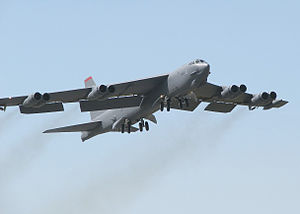United States Air Force: Difference between revisions
Jump to navigation
Jump to search


imported>Howard C. Berkowitz |
Pat Palmer (talk | contribs) mNo edit summary |
||
| (10 intermediate revisions by 3 users not shown) | |||
| Line 1: | Line 1: | ||
{{subpages}} | {{subpages}} | ||
[[Image:b52.climbout.arp.jpg|thumb|right|[[B-52|Boeing B-52]] strategic bomber taking off.]] | |||
The '''United States Air Force''' ('''USAF''') is | The '''United States Air Force''' ('''USAF''') is the air service branch of the country's armed forces, and is part of the [[Department of Defense]]. It was founded on 1 August 1907 as part of the United States Army Signal Corps, and then re-established in 1947 as a service branch in its own right. | ||
==References== | |||
{{reflist}} | |||
{{ | |||
[[Category:Reviewed Passed if Improved]] | |||
Revision as of 12:16, 8 April 2024

Boeing B-52 strategic bomber taking off.
The United States Air Force (USAF) is the air service branch of the country's armed forces, and is part of the Department of Defense. It was founded on 1 August 1907 as part of the United States Army Signal Corps, and then re-established in 1947 as a service branch in its own right.